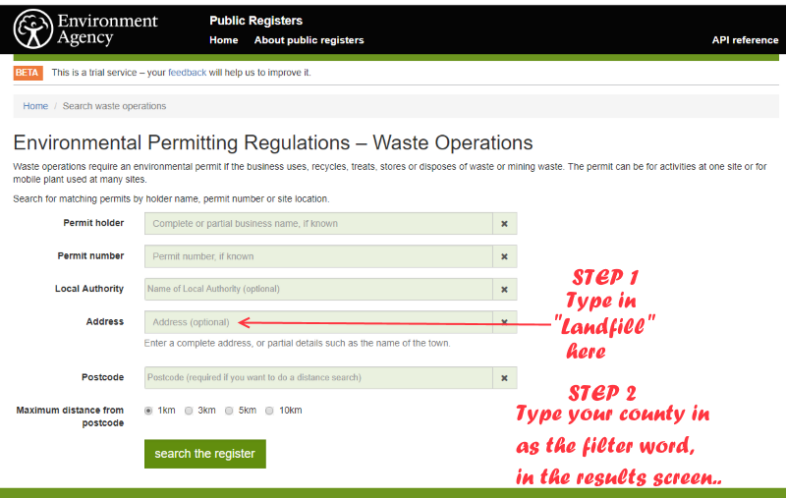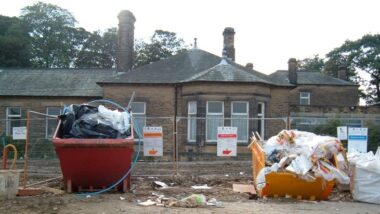Inert waste means “waste that does not undergo any significant physical, chemical or biological transformations”.
Inert waste will not dissolve, burn or otherwise physically or chemically react, biodegrade or adversely affect other matter with which it comes into contact in a way likely to give rise to environmental pollution or harm to human health.
The total leachability and pollutant content of the waste and the ecotoxicity of the leachate must be insignificant, and in particular not endanger the quality of surface water and/or groundwater.
This is the WAMITAB (Waste Management Industry Training & Advisory Board) definition. Visit WAMITAB here.
How to Find an Inert Waste Landfill Near You in England
There is no central register of active waste landfills in the UK. Finding an inert landfill is usually even less straightforward.
One way would be to talk to waste hauliers in the area and other contractors who may know sites, such as farms which need non-reactive materials such as gravel and stone. Some will be looking for stone to improve farm tracks etc., and will accept very clean granular soils.
Another way would be to contact active waste landfills and ask whether they accept your excess inert excavated soils, for use in developing their landfill.
Landfills are permitted to accept inert waste for use in their temporary and permanent access roads. They may also use it in screening bunds, and restoration materials.
The is a landfill tax to pay, but it is at the lower rate of between £2 and £3 per tonne. The landfill operator may also impose a gate fee.
To find an active landfill willing to accept your excess site soils, you might contact all the big 5 waste companies in turn. You would ask their Head Office staff where they accept inert waste, and how much they would charge, but that is a time consuming process. There are many landfill operators which you would be contacting who won’t even have a landfill in your area.
To make getting that list of landfill site location in England, with company names and a full address easier we have devised an unofficial method of obtaining the most up tod ate list of these landfills.
Our Unofficial 2 Step Way to Find Landfills in England
To find an inert waste landfill which may be willing to accept your inert waste carry out the following:
- Find a list of landfills in England. To do this we suggest that you use the Environment Agencies public register at environment.data.gov.uk.
- From the register only partially complete the form to find find landfills (provided for England only), as shown on the image above
- home-in to landfills near you by filtering the search results for your county name.
Contact the landfill operator from the address provided. Call and ask their receptionist/ weighbridge clerk, whether they accept inert waste at that landfill.
Although the EA’s register is not primarily intended as a tool for this purpose you will find most if you search on company name words such as waste or landfill, and you can then refine the search using the built-in filter for your county using the address box.
We have provided a list of UK (England) Landfill Sites here.
Inert materials suitable for acceptance, include soil, sand, clay, concrete and more
The Problem With Many Historic Inert Waste Landfills
In terms of the water chemistry, an increased COD, some BOD, and a significant ammoniacal nitrogen above background concentrations, is all that is needed to result in a polluted area of groundwater, and/ or surface water. In such cases this is described as leachate contamination.
How to Reduce Methane Emissions at Home
Many homes contribute to methane emissions without knowing it. Methane is a potent greenhouse gas that harms our environment. This blog will guide you through practical steps to reduce these emissions right from your home. Read on to make a change! Key Takeaways Understanding Methane Emissions What is methane and its environmental impact at home? […]
The Future of UK Food Waste Management – Simpler Collections and Tougher Regulation
The future of UK food waste management will be a big push toward higher recycling rates through simpler collection and far greater consistency across the nations, helping citizens understand how to be green and recycle more organic waste. As the UK continues to advance its environmental goals, recently announced government policies aimed at simplifying waste […]
Understanding the Benefits and Drawbacks of Sanitary Landfill Sites
In this article, you will find out about the advantages and disadvantages of sanitary landfills. Deciding on the best way to handle rubbish, is a common challenge, especially in developing nations. Sanitary landfills offer one solution, but they come with pros and cons. This article will help you understand these landfill sites better, including their benefits and drawbacks. Stay […]
Cost of Commercial Waste Disposal UK: Keeping the Numbers Low: What UK Rubbish Really Costs
Managing rubbish costs money. UK companies know this too well, as they deal with heaps of trash every day. Every year, these businesses create 27.5 million tonnes of commercial waste and 13.6 million tonnes of industrial waste – that’s a mountain weighing 41.1 million tonnes! Tossing all that waste can eat up to 4-5% of […]










Hi! This is your Admin:
We wrote this page to help visitors find an Inert Waste Landfill in England.
If you were looking for an inert waste site elsewhere, PLEASE comment to tell me where you want to find YOUR inert waste site.
If we see enough comments for other nations, we will write a specific page for those nations we see here in your commented requests.